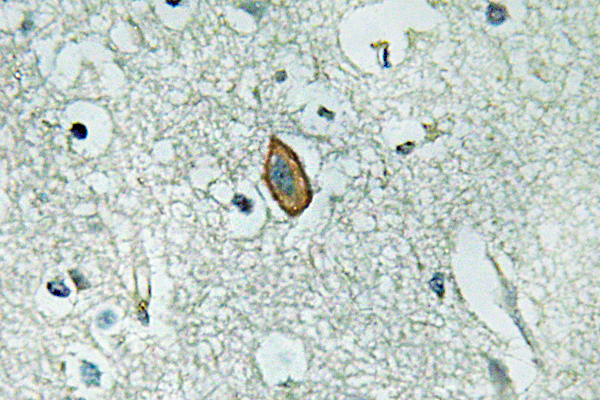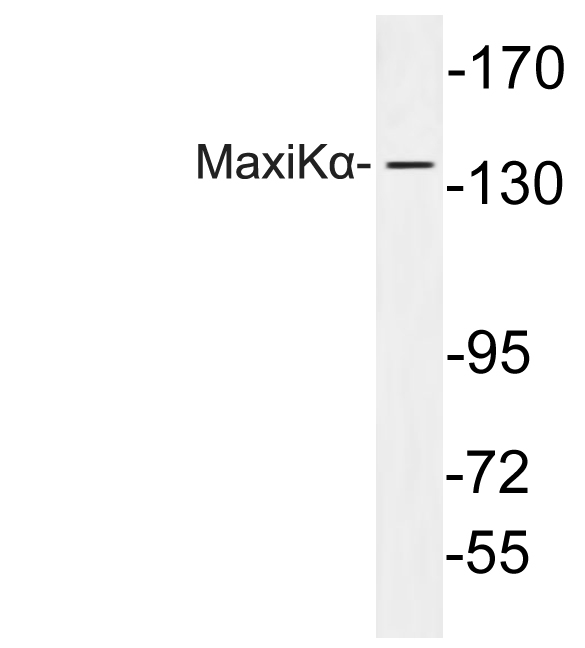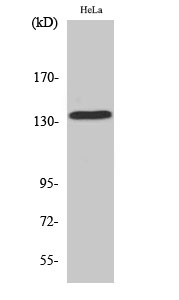产品名称
MaxiKα Rabbit Polyclonal Antibody
别名
KCNMA1; KCNMA; SLO; Calcium-activated potassium channel subunit alpha-1; BK channel; BKCA alpha; Calcium-activated potassium channel; subfamily M subunit alpha-1; K(VCA)alpha; KCa1.1; Maxi K channel; MaxiK; Slo-alpha; Slo1; Slowpoke homolog
蛋白名称
Calcium-activated potassium channel subunit alpha-1
存储缓冲液
Liquid in PBS containing 50% glycerol, 0.5% BSA and 0.02% New type preservative N.
Human Gene Link
http://www.ncbi.nlm.nih.gov/sites/entrez?db=gene&term=3778
Human Swissprot No.
Q12791
Human Swissprot Link
http://www.uniprot.org/uniprotkb/Q12791/entry
Mouse Gene Link
http://www.ncbi.nlm.nih.gov/sites/entrez?db=gene&term=16531
Mouse Swissprot No.
Q08460
Mouse Swissprot Link
http://www.uniprot.org/uniprot/Q08460
Rat Gene Link
http://www.ncbi.nlm.nih.gov/sites/entrez?db=gene&term=83731
Rat Swissprot Link
http://www.uniprot.org/uniprot/Q62976
免疫原
The antiserum was produced against synthesized peptide derived from human MaxiKalpha. AA range:721-770
特异性
MaxiKα Polyclonal Antibody detects endogenous levels of MaxiKα protein.
稀释度
WB 1:500 - 1:2000. IHC 1:100 - 1:300. ELISA: 1:40000.. IF 1:50-200
宿主
Polyclonal, Rabbit,IgG
背景介绍
potassium calcium-activated channel subfamily M alpha 1(KCNMA1) Homo sapiens MaxiK channels are large conductance, voltage and calcium-sensitive potassium channels which are fundamental to the control of smooth muscle tone and neuronal excitability. MaxiK channels can be formed by 2 subunits: the pore-forming alpha subunit, which is the product of this gene, and the modulatory beta subunit. Intracellular calcium regulates the physical association between the alpha and beta subunits. Alternatively spliced transcript variants encoding different isoforms have been identified. [provided by RefSeq, Jul 2008],
组织表达
Widely expressed. Except in myocytes, it is almost ubiquitously expressed.
细胞定位
Cell membrane ; Multi-pass membrane protein .
信号通路
Vascular smooth muscle contraction;
功能
alternative products:May be partially controlled by hormonal stress. Additional isoforms seem to exist,disease:Defects in KCNMA1 are the cause of generalized epilepsy and paroxysmal dyskinesia (GEPD) [MIM:609446]. Epilepsy is one of the most common and debilitating neurological disorders. Paroxysmal dyskinesias are neurological disorders characterized by sudden, unpredictable, disabling attacks of involuntary movement often requiring life-long treatment. The coexistence of epilepsy and paroxysmal dyskinesia in the same individual or family is an increasingly recognized phenomenon. Patients manifest absence seizures, generalized tonic-clonic seizures, paroxysmal nonkinesigenic dyskinesia, involuntary dystonic or choreiform movements. Onset is usually in childhood and patients may have seizures only, dyskinesia only, or both.,domain:The calcium bowl constitutes one of the Ca(2+) sensors and probably acts as a Ca(2+)-binding site. There are however other Ca(2+) sensors regions required for activation of the channel.,domain:The heme-binding motif mediates inhibition of channel activation by heme. Carbon monoxide-bound heme leads to increased channel activation.,domain:The pore-forming domain (also referred as P region) is imbedded into the membrane, and forms the selectivity filter of the pore. It contains the signature sequence of potassium channels that displays selectivity to potassium.,domain:The RCK N-terminal domain mediates the homotetramerization, thereby promoting the assembly of monomers into functional potassium channel. It includes binding sites for Ca(2+) and Mg(2+).,domain:The S0 segment is essential for the modulation by the accessory beta subunits KCNMB1, KCNMB2, KCNMB3 and KCNMB4.,domain:The S4 segment, which is characterized by a series of positively charged amino acids at every third position, is part of the voltage-sensor.,enzyme regulation:Ethanol and carbon monoxide-bound heme increase channel activation. Heme inhibits channel activation.,function:Potassium channel activated by both membrane depolarization or increase in cytosolic Ca(2+) that mediates export of K(+). It is also activated by the concentration of cytosolic Mg(2+). Its activation dampens the excitatory events that elevate the cytosolic Ca(2+) concentration and/or depolarize the cell membrane. It therefore contributes to repolarization of the membrane potential. Plays a key role in controlling excitability in a number of systems, such as regulation of the contraction of smooth muscle, the tuning of hair cells in the cochlea, regulation of transmitter release, and innate immunity. In smooth muscles, its activation by high level of Ca(2+), caused by ryanodine receptors in the sarcoplasmic reticulum, regulates the membrane potential. In cochlea cells, its number and kinetic properties partly determine the characteristic frequency of each hair cell and thereby helps to establish a tonotopic map. Kinetics of KCNMA1 channels are determined by alternative splicing, phosphorylation status and its combination with modulating beta subunits. Highly sensitive to both iberiotoxin (IbTx) and charybdotoxin (CTX).,miscellaneous:The protein was initially thought to contain two functionally distinct parts: The core channel (from the N-terminus to the S9 segment) that mediates the channel activity, and the cytoplasmic tail (from the S9 segment to the C-terminus) that mediates the calcium sensing. The situation is however more complex, since the core channel also contains binding sites for Ca(2+) and Mg(2+).,PTM:Phosphorylated (Probable). Phosphorylation by kinases such as PKA and/or PKG. In smooth muscles, phosphorylation affects its activity.,sequence caution:Contaminating sequence. Sequence of unknown origin in the N-terminal part.,similarity:Belongs to the potassium channel family. Calcium-activated subfamily.,similarity:Contains 1 RCK N-terminal domain.,subunit:Homotetramer; which constitutes the calcium-activated potassium channel. Interacts with beta subunits KCNMB1, KCNMB2, KCNMB3 and KCNMB4. Beta subunits are accessory, and modulate its activity.,tissue specificity:Widely expressed. Except in myocytes, it is almost ubiquitously expressed.,
纯化
The antibody was affinity-purified from rabbit antiserum by affinity-chromatography using epitope-specific immunogen.



